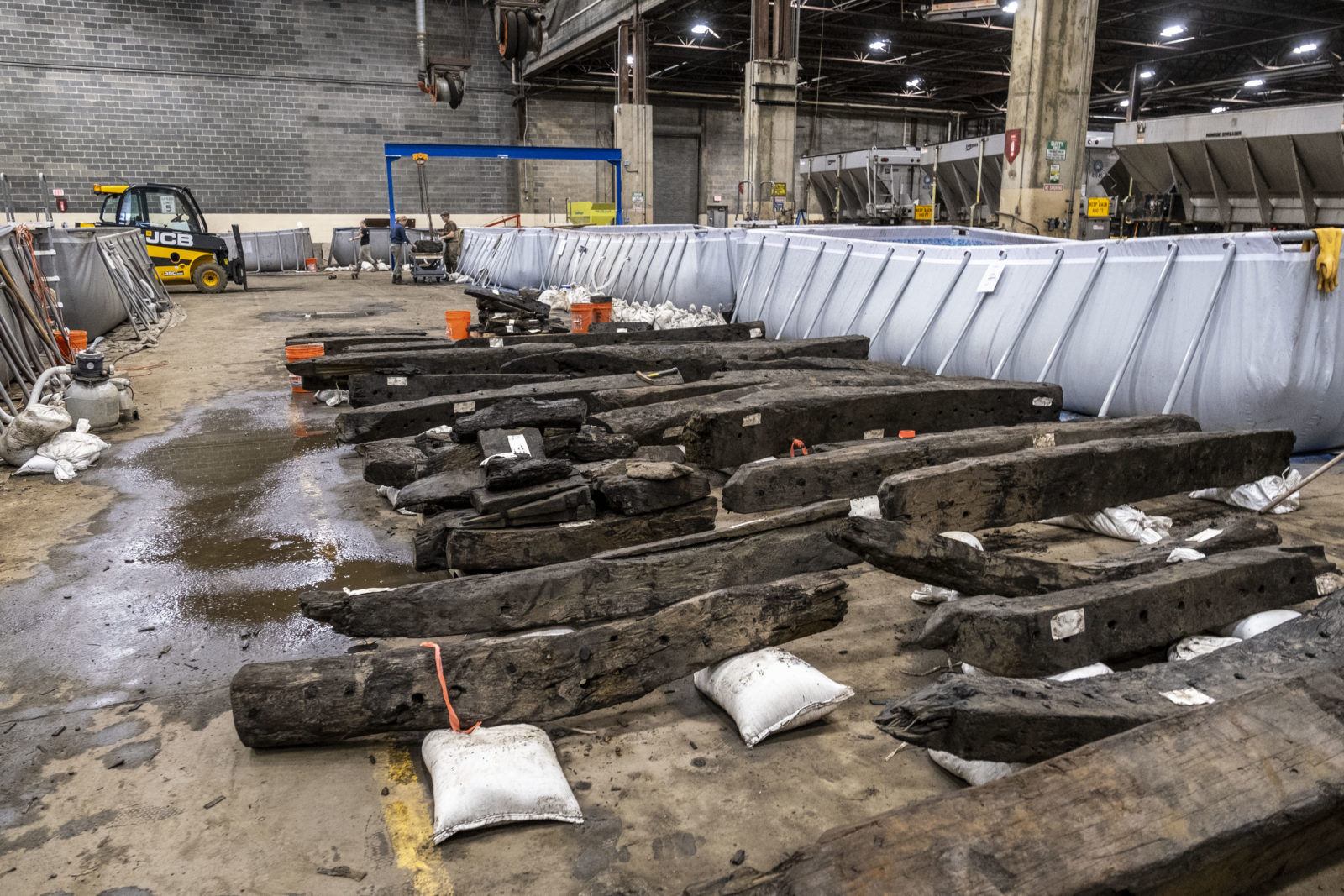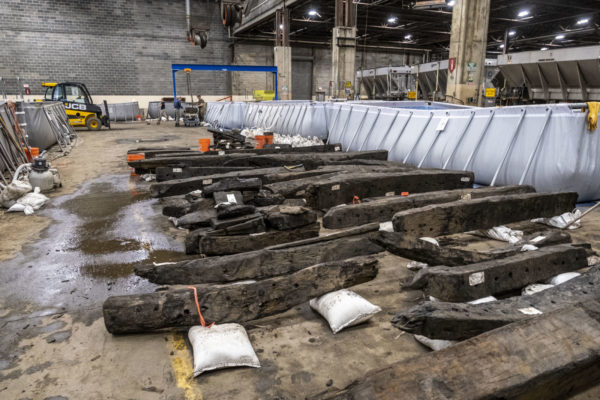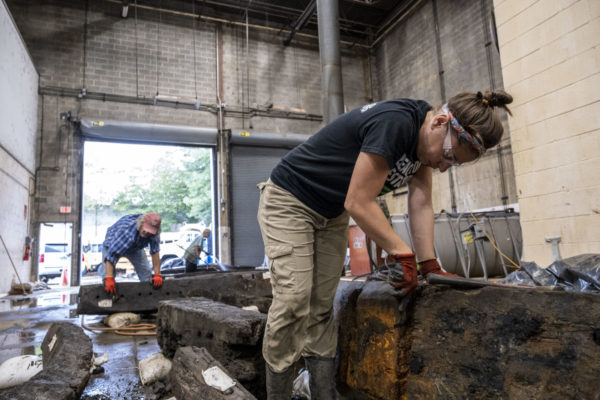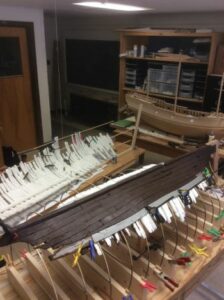
(Updated 11:15 a.m.) A new ‘windowfront exhibit’ about the Buried Ships of Robinson Landing is coming to Old Town early next month.
The exhibit features scale models of four 18th and 19th-century ships discovered during excavations of the Robinson Landing Site.
According to an event listing:
In 2018, archaeologists excavated the three historic vessels from the Robinson Landing Site, on the same block as the new exhibit. The scale models show what these ships may have looked like in the late 18th and early 19th centuries. Archaeologists will join City officials to speak on the exhibit’s debut.
The exhibit is set to open on Saturday, April 6, at the corner of the Strand and Pioneer Mill Way. The ribbon-cutting will be that day at 1 p.m.
The models will be on display in Old Town. Three of the original ships have re-sunk in the pond at Ben Brenman Park as part of a preservation effort, while the third is still at Texas A&M undergoing conservation work.

One year after Alexandria re-sunk historic ships into the pond at Ben Brenman Park, City Archeologist Eleanor Breen said studies show the unconventional preservation project is working as intended.
Back in 2018 during work on the Robinson Landing project, a group of somewhat intact hulls were discovered underground. They’d been scuttled beneath the ground, likely as part of the foundation of the new waterline.
Without proper water treatment, the water-logged timbers would grow damaged after being exposed to the surface. If they dry out, the wood will warp, shrink and crack. So while one of the ships was sent to Texas A&M for study, the city opted to send the other three back to Davy Jones’ Locker — specifically in Ben Brenman Pond.
While re-submerging ships to preserve has been done before, Breen said Alexandria’s project was still at a unique scale within the United States.
“It’s definitely an innovative storage solution,” Breen said. “It’s one they do in Europe often but not quite as frequently in the United States. There were similar ones in Maryland and Ohio, but this is far larger… One may be the largest 18th-century merchant ship that’s been excavated.”
Recently, Breen said divers went back to the wrecks in Ben Brenman Pond to see if the preservation methods have been working.
“They unwrapped them and checked on them with archeologists and conservators,” Breen said. “They did that detailed process and found that overall the plan is working as intended. They’re in stable condition… Everything is going as expected and the best news is a blanket of silt has started to accumulate on top of the timbers, replicating the original burial environment.”
Divers are scheduled to go back down for another check on the ships in Ben Brenman Pond in spring 2028.
Meanwhile, Breen said the ship at Texas A&M will likely remain there for another two and a half years undergoing conservation efforts before returning to Alexandria.
Five years after buried ship timbers in Old Town were shipped off to Texas A&M for study, the director of that research team is hosting a virtual lecture to discuss their findings.
Christopher Dostal is the Director of the Center for Maritime Archaeology and Conservation and the Director of the Analytical Archaeology Laboratory that scanned four 18th century ships dug up in Old Town.
“To study them, each ship was disarticulated and the individual timbers were laser scanned, allowing researchers to virtually reassemble the ships and develop theoretical reconstructions of how they would have looked when they were in use,” the City of Alexandria said in a release. “These highly accurate digital timber models were 3D printed and assembled by a master ship model maker, further informing these reconstructions.”
The process of dendrochronology — the study of dating tree rings that can help identify information about timber — has already provided some insight into the storied lives of these ships.
Now, the fleet is scattered once more. The ship found at the Hotel Indigo site was sent off to Texas A&M for conservation work. The other three ships found at the Robinson Landing site were re-sunk at a pond in Ben Brenman Park earlier this year.
The release said the lecture will discuss the latest findings from efforts to digitally reconstruct the four ships.
The lecture if scheduled for Wednesday, Oct. 26, from 7-8 p.m. The lecture is free, but registration is required.
Fieldwork started earlier this week on a project to put the Old Town ships back underwater, and a public event scheduled next Sunday will give locals a chance to discuss the process with city archaeologists.
The public event, called “SeeWorthy in the Park,” is scheduled for Sunday, May 15, from noon to 4 p.m. at Ben Brenman Park (4800 Brenman Park Drive). The name SeeWorthy is derived from a new exhibit in the Torpedo Factory featuring digital reconstructions of the ships.
“The free event will include opportunities to talk with archaeologists about ship research and preservation, as well as STEM (Science, Technology, Engineering and Math)-based activities for all ages, such as shoreline engineering, wood preservation, and forklift hydraulics,” the city said in a release.
After the ships were uncovered in 2018, they were kept in tanks of water to prevent the wood from decaying. The timbers keep their shape when submerged but if the wood dries out they could crumble. Some pieces of the largest ship have been undergoing restorative treatment and study at Texas A&M, but timbers from the other two ships have been taking up space in a DASH bus facility since their discovery.
In an earlier meeting, City Archaeologist Eleanor Breen said Ben Brenman Park Pond was chosen as having the least risk of contamination or damage to the frames while also being the easiest to access. Breen said signage will be added to the park explaining the history of the ship fragments. Meanwhile, a study of a potential waterfront museum is scheduled to start later this year and could be a permanent home for at least one of the ship hulls.
Work on the re-sinking started on Monday, May 2, and is scheduled to continue for around 4-6 weeks.
“These rare and unique artifacts represent Alexandria’s historic seaport,” Breen said in a release. “We look forward to sharing the story of their discovery, excavation, and preservation with Alexandria residents and visitors in the Alexandria Archaeology Museum and in many other ways.”
Work is scheduled to start next month on one of Alexandria’s more bizarre projects: putting a set of historic ship hulls recovered in Old Town back underwater.
Ben Brenman Park Pond (4800 Brenman Park Drive) near Cameron Station will be playing the part of Davy Jones’ Locker for the project. The city is hosting a meeting on-site next week to discuss the project.
“The public is invited to attend a Community Pre-Construction Meeting about the upcoming project to place the Robinson Landing Site historic ship timbers in Ben Brenman Park Pond,” the city said in a release. “The meeting will be held on Tuesday, April 19, 5:30 p.m. at Ben Brenman Park at the maintenance access point on the pond along Deer Run Court.”
After the ships were uncovered in 2018, they were kept in tanks of water to prevent the wood from decaying. The timbers keep their shape when submerged but if the wood dries out they could crumble. Some pieces of the largest ship have been undergoing restorative treatment and study at Texas A&M, but timbers from the other two ships have been taking up space in a DASH bus facility since their discovery.
In an earlier meeting, City Archaeologist Eleanor Breen said Ben Brenman Park Pond was chosen as having the least risk of contamination or damage to the frames while also being the easiest to access. Breen said signage will be added to the park explaining the history of the ship fragments. Meanwhile, a study of a potential waterfront museum is scheduled to start later this year and could be a permanent home for at least one of the ship hulls.
The city release said fieldwork at the park is expected to run from May 2 to May 27.
Almost exactly four years after archeologists recovered three 18th-century ships from under the Old Town Waterfront, Alexandria is planning on sending at least two of them back to Davy Jones’ Locker.
Three ships were discovered under the Robinson Landing construction site in March 2018. While the most intact of the trio was sent to Texas A&M for study and will get a new Torpedo Factory exhibit next month, the other two have sat in water tanks in the DASH bus barn. At a meeting of the Waterfront Commission, City Archaeologist Eleanor Breen said that sometime this year the city will start moving the ships out of their 12×24-foot tanks and out to Ben Brenman Pond (4800 Brenman Park Drive).
“Based on [an] assessment, the recommendation was that [the ships] be stored at the bottom of Ben Brenman Pond; at the south end of the pond,” Breen said. “Jack [Browand, division chief of Parks and Cultural Activities] summarized it perfectly the other day: ‘We’re resinking three ships in a pond five miles west of where they were found.”
Breen noted this isn’t the first time rediscovered ships from this time period have been resubmerged. A Revolutionary War-era barge was discovered then re-submerged near Baltimore. Breen said the pond was chosen because it was the least risky to the timbers and would be the easiest to access. The “ponding” project received funding in the FY 2021 CIP.
“We’re finalizing the project schedule, including a date for pre-construction meeting on-site,” Breen said. “It will begin in April and last 4-6 months. We will offer a family-friendly event during ‘ponding’ process and in the future will be installing site interpretation.”
Meanwhile, Breen said a feasibility study for a potential new waterfront museum could start later this year with the idea of the museum eventually being home to the most intact ship. The study will look at potential funding and business models, as well as reviewing the sustainability of a waterfront museum.
The Alexandria Archaeology Museum announced on Twitter that a new exhibit coming to the Torpedo Factory will offer a digital guided tour of one of the ships found buried under Old Town’s waterfront.
In 2018, hulls from three mid-18th century ships were found buried underground during an excavation at the Robinson Landing development. The crown jewel of the archeological discovery, however, was a mostly intact lower hull from one of the ships.
The ship has become an object of intense study and even some belated shipbuilding criticism. The hull was even carefully taken apart and sent in pieces to Texas A&M for further study.
The eventual fate of the ship still remains unknown, with the idea of a new Waterfront Museum having been floated around as a possible home.
The new exhibit won’t take up as much space as the full ship eventually will: it’s opening in Studio #9 on the Torpedo Factory’s first floor.
The exhibit is scheduled to open Friday, April 1, and will be there until June.
View ship construction through the eyes of maritime archaeologists in SeeWorthy a new exhibit highlighting the technology used to digitally reconstruct historic vessels. The exhibit opens on 4/1 in Studio #9, on the 1st floor of the Torpedo Factory Art Center #WaterfrontWednesday pic.twitter.com/5KS8gX2yjp
— AlexVA Archaeology (@AlexArchaeology) March 16, 2022
The discovery of the Old Town Armada was an unexpected boon to Alexandria archeologists. But impressive as it is that so much of the three ships have remained intact after centuries underground, recent archeological work has uncovered an interesting detail on one of them.
Somebody screwed up.
As part of the ongoing study of the ships, the Conservation Research Lab discovered a flaw in the ship’s design that likely handicapped its seaworthiness.
“Creating the model for Ship #2 has exposed an interesting feature associated with the ship’s construction,” the lab reported. “There is a bump in the planking on the starboard side of the vessel. This is because the ship’s carpenters accidentally made five floor timbers too flat in this area but noticed their mistake when they started planking the vessel.”
A dendrochronological study of the timbers on the timbers identified that at least one of the ships was most likely made in the Boston-area and likely used to make cargo runs to the Caribbean. The error was found as the lab was putting together digital and physical models of the three ships.
“The process of creating a digital model entails piecing together individual timber scans to recreate the archaeologically recovered ship remnant,” the lab said. “It is a time-consuming process to ensure that the timbers align correctly and produce a faithful digital model for future study, interpretation, and education.”
The lab reported that to compensate for the error, carpenters likely had to form the hull planking around the bump, creating an S-shape in the hull that made it slightly more cumbersome to sail, which is perhaps why it and two other past-their-prime ships were deliberately buried as part of the waterfront expansion in the 18th century.
“This defect probably affected the vessel’s sailing ability because the bump would have disrupted the hull’s hydrodynamics,” the lab reported. “This 200-year-old foible is not particularly significant in the larger picture, but it does speak to the human capacity to both make and compensate for mistakes.”
Via City of Alexandria
Alexandria’s Archeology Museum is inviting the public to come see its new exhibition on ships long-ago sunk to build the city’s waterfront.
This Saturday, October 19, the public will be able to see for themselves how archeologists and volunteers have worked to excavate and restore four of the ships in time for Archeology Month.
The museum will open the free exhibition from 11 a.m.-4 p.m. at its public lab at 105 North Union Street.
“Recent development along the waterfront has led to significant discoveries by archaeologists, including the remains of four historic ships,” the museum wrote in its description of the upcoming event.
“Follow the story of the city’s archaeologically recovered maritime heritage from excavation to preservation,” it added. “View a 3D model of one of the historic vessels and find out how archaeologists are answering questions about the age and use of the ships, as well as what role they may have played in Alexandria’s early economy.”
The exhibit is sponsored in part by the Historic Alexandria Foundation.
Those who need accommodations for disabilities can request them by contacting the museum at [email protected] or call 703.746-4399 or Virginia Relay 711.
(Updated 10/17) New details are coming in about one of Alexandria’s long-buried ships.
Two hundred years after the ship was scuttled to be built into the artificial waterfront, teams in Texas and here in Alexandria are putting the ship back into a stable condition and learn more about them.
“We’re starting to put the picture back together of what the ship may have looked like when it sailed,” said Eleanor Breen, City Archaeologist for Alexandria.
In April 2018, a construction crew at the Robinson Terminal South site (300 S. Union Street) found the remains of several ships buried underground, including one particularly large ship with a relatively intact hull.
“The remnant in the ground was 50 feet long, but they think the ship was about 70 feet long when it sailed,” said Breen. “They’re speculating it was likely a brig or a large sloop.”
Using dendrochronology — the study of tree rings to learn more about the age and history of wood — Breen said her team was able to find that the ship was built sometime after 1741.
Currently, the ship is at the Conservation Research Laboratory at Texas A&M University, where a team is working to carefully extract the corrosive iron from the ship without damaging the timbers.
“We need to first extract all of the iron that was in the wood as possible,” said Dr. Peter Fix, head of Conservation and Reconstruction for La Belle. “The ship was held together in part by iron fastenings. As they corroded during service or in the ground, that corrosion product permeated into the timber itself and will cause lots of problems down the line if we don’t manage that now.”
Once the iron is removed from the wood, Fix said the team will have to apply a chemical substance — polyethylene glycol — that will fill in the gaps in the cellular structure caused by bacteria eating away at the wood. Those gaps are currently filled with water, meaning the ship is required to remain hydrated or it will lose its shape.
“If we were to just leave the wood on the street and allow it to evaporate out, that would alter the shape of the timbers significantly,” Fix said. “So what we have to do is displace that water and put it into a freeze dryer and by the process of freeze-drying, we will gently remove whatever water is remaining.”
Fix said filling those gaps with polyethylene glycol should be a permanent fix… provided the ship isn’t suddenly inundated with water again. As they work on the ship, Fix says they’re learning more about the impressive craftsman that went into the vessel.



